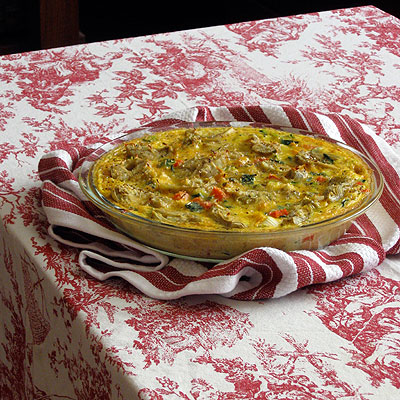
Artichoke Clafouti: It’s probably obvious. But in case you didn’t know it. I can be a sentimental fool.
I can get weepy at the silliest things. Yet actual physical pain barely phases me. When I broke my jaw in Sonoma last year I drove all the way home to Los Angeles barely registering the massive injury I had sustained. I had to hold my jaw in place with my hand, but I didn’t cry.
But say clafouti to me, and I begin to tear up. Mis-pronounce it and watch the tears flow.
That’s because my mother had her very special way of pronouncing some words. Clafouti was one of those words. Now she had a pretty good grasp of the French language, but she could not get the emphasis on the proper syllable in clafouti. Of course, there was no correcting her. She wasn’t the type of person who took criticism well. She would just stare at you blankly like she had no idea what you were talking about. So when she had a way of saying a word, well that’s the way a word would be said forever. Don’t get me started on schedule. I may start balling and never stop!
This is Day 3 in my week-long tribute to my mother and her cooking. She may be gone, but thanks to a collection of her recipes my brother compiled after her death, her spirit lives on in pages of delicious memories from my youth.
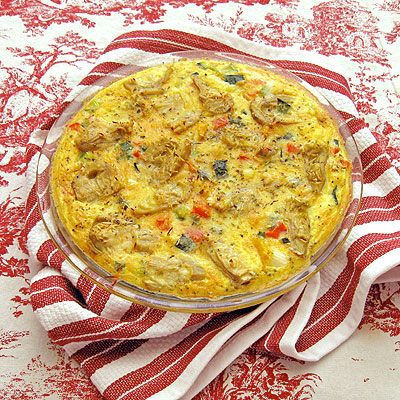 Artichoke Clafouti
Artichoke Clafouti
But we are here about clafouti, or at least what my mother called clafouti. To you, this may be more of a crustless quiche. Either way, it’s a savory egg custard baked in a bain-marie until it barely holds it’s form. It makes a wonderful brunch or light supper. But it would be acceptable as a side dish too I suppose.
I just realized this may be my version of staring at you blankly acting like I have no idea what you are talking about. Because I have assumed you know what clafouti is. Well, to start off it is properly called clafoutis, even in the singular. But in English speaking countries the S is usually dropped. That’s because when those wacky French people put an S at the end of a word, they don’t even bother to pronounce it. So CLAFOUTIS or CLAFOUTI are both pronounced kla-foo-TEE. Unless you’re my mother, then it is pronounced KLAF-a-tee.
But what is clafouti? Well at it’s most technical it is a rustic looking French country dessert from the Limousin region that has become very popular in North America. Traditionally it was made with the first sweet cherries of the season. Typically the cherries are not pitted so the pitts can release their delicate almond flavor as they bake. But of course in this country, they are usually pitted (nuance is often lost on us…). When other kinds of fruit are used instead of cherries, the dish is called a flaugnarde. When artichokes are used instead of cherries or other fruit it is called KLAF-a-tee. Or so said, my mother…
Artichoke Clafouti Serves 4 as a main course 8 as a side dish CLICK here for a printable version.
- 1 pk (9oz) frozen artichoke hearts
- 1 small red bell pepper
- 1 small yellow bell pepper
- 1 small zucchini
- 4 green onions, white and light green parts
- 2 T olive oil
- 1 clv garlic, peeled and minced
- 1⁄2 t dried oregano
- salt and white pepper as needed
- 1 pn ground nutmeg
- 2 T store-bought breadcrumbs
- 4 large eggs, room temperature
- 1 c half and half room temperature
- 3 T flour
- 1⁄2 c parmesan cheese, grated
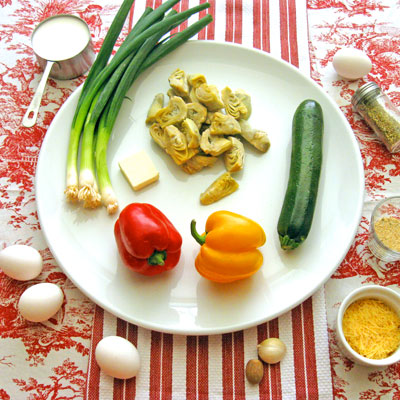 Preheat oven to 325 degrees F. Blanch artichokes in lightly salted boiling water for one minute. Drain and set aside.
Preheat oven to 325 degrees F. Blanch artichokes in lightly salted boiling water for one minute. Drain and set aside.
Remove the stem core and dice the bell peppers. Dice the zucchini. Thinly slice the green onions. Heat a large skillet over medium-high heat. Add the olive oil and garlic. Stir until fragrant. Add the green onions to the skillet, stir to coat. Add oregano, a pinch of salt and white pepper, and a pinch of ground nutmeg. Add the artichokes, bell peppers and zucchini. Cook the vegetables about 4 minutes until slightly softened. Turn off the heat and set aside.It may be made ahead to this point and refrigerated up to 2 days.
At the serving time. Butter the bottom and sides of an 8‑inch glass or ceramic shallow baking dish or pie pan. Dust it with the breadcrumbs, shaking out excess. Break the eggs into a bowl and whisk in the half and half and flour. Whisk vigorously, until tiny bubbles are suspended in the mixture. Immediately add the cooled vegetables and the Parmesan cheese, and another pinch of salt, mix well. Pour this mixture into the prepared dish.
Set the filled dish into the center of a larger baking pan and fill the larger pan with warm water until it comes about halfway up the sides of the filled dish. Carefully move the pans to the oven and bake about 30 minutes, or until a knife inserted in the center comes out clean. Do not overcook the custard should remain tender and barely hold together. Serve warm or at room temperature.
SERIOUS FUN FOOD
Greg Henry
SippitySup
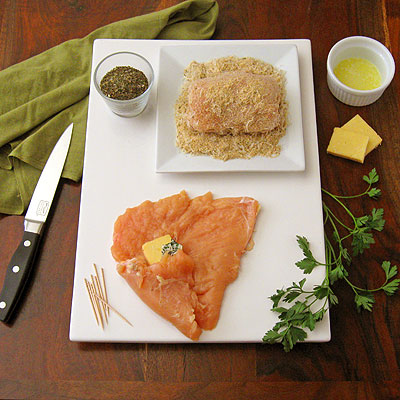
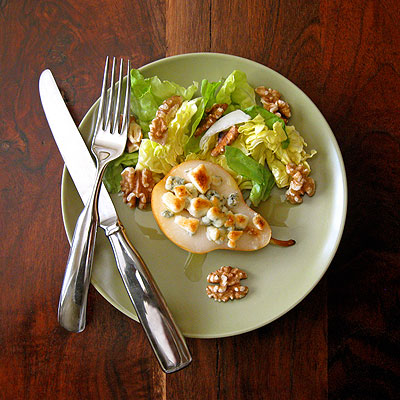
It was very nice but I had several small problems, the first one is that my potatoes were not cooked when I just simmered the dish and the most important is that it has a bitter aftertaste.
Wow..I wanna try that at home..Looks like fried chicken..Looks very yummy 🙂
I just made this. Had to make a few substitutions myself (I’ve been away at college and my pantry at home is quite as well-stocked as I remember it being…), but dear God — this is the best thing I’ve eaten in awhile! So good!
I don’t know how I missed this; I follow No Recipes! I guess yours just looked tastier! Thanks for sharing your changes!
Most of us probably do that anyways. It’s so much easier than being a slave to so many measurements and ‘procedures’. 🙂
I thought it was chicken at first! All those spices sound fantastic, I know what I’m making for dinner tonight, thanks for the recipe!
i love how you talk about being more adventurous about what you cook and how blogs have helped you do that. i definitely would not have tried some of the dishes i now love if it were not for other food blogs. great post:)
Greg, what a lovely dish and I don’t even care for cauliflower. Guess I should give it another chance.
Sam
This looks incredibly appetizing. A large part of being able to cook involves having a well stocked pantry but the other part is learning how to substitute/cope when you don’t have the exact ingredients on hand. An experienced and knowledgeable palate is key.
I’m confused. You’re suppose to leave the cloves in whole? They stay in the dish when served? I don’t remember ever chomping into a whole piece of clove in Indian food.
I guess they break down after nearly an hour of cooking, because I didn’t run across any broken teeth! GREG
Terrific flavors in this dish, I would love to make it too!
I was really excited to see a “pantry workout.” I would be all over that :). Your dish looks amazing! Wish I had some cauliflower in my pantry.
I can’t say how long I have been meaning to cook this dish well probably a decade; I am glad you are doing it for me; that’s half the battle.
I think cauliflower and spices are a good marriage, don’t you?
I guess that explains the stains on the dining room chair;) 🙂 =))
This looks seriously sippity sup super, Greg! I have a great pantry too.…it’s called, “Hey honey, do you need to go to the store for anything?”
Great post as always Greg.
Aloo Gobi! Yours look beautiful!
This looks tasty as well as having cauliflower in it — which I love — the spices at the beginning sound wonderful.
I think that’s the beauty of cooking. You can create and refine recipes with things you have on hand to match your tastes and possible those who read the recipes. I haven’t had Idian food in such a long time. I miss it.
I love that you made this right away. I also love the blue tablecloth you used as a backdrop. It looks like your aloo gobi is floating gently in the ocean of wonderfulness.
I love that you have mostly original recipes — those are my favorite blogs, the ones who can help me discover something I can’t find in a book. I try to do the same thing — especially the part about making it sound well-planned. Really love this recipe. I’ve been trying to cook more Indian lately, so I will add this to the list.
Glad you found inspiration to do your own thing with this, that’s really what my blog is about and where the name comes from. I also like the sound of the caraway seeds as I love cabbage and caraway. Nice job:-)
… is the strength of your knowledge about flavors and ingredients, that you can deftly make this dish without having everything you could ever need in your pantry! I do not yet have that depth to know, for instance, that caraway seeds could add the needed pungency. Wonderful dish!